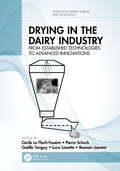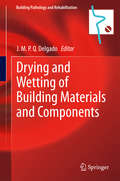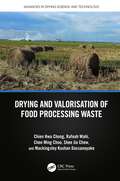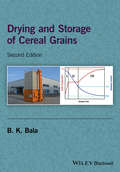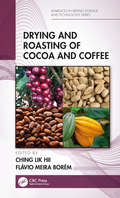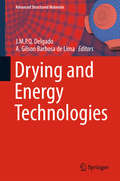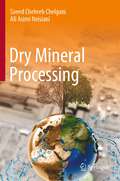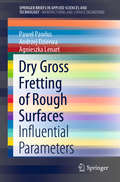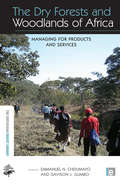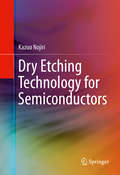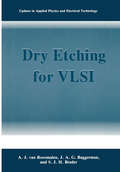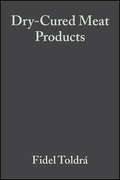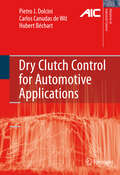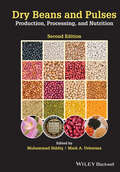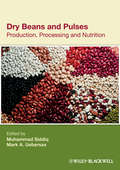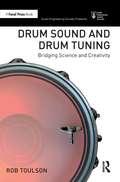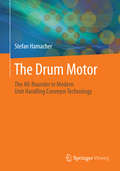- Table View
- List View
Drying in the Dairy Industry: From Established Technologies to Advanced Innovations (Advances in Drying Science and Technology)
by CécilePierreGaëlleLucaRomain Le Floch-Fouéré Schuck Tanguy Lanotte JeantetWith more than 12M tons of dairy powders produced each year at a global scale, the drying sector accounts to a large extent for the processing of milk and whey. It is generally considered that 40% of the dry matter collected overall ends up in a powder form. Moreover, nutritional dairy products presented in a dry form (eg, infant milk formulae) have grown quickly over the last decade, now accounting for a large share of the profit of the sector. Drying in the Dairy Industry: From Established Technologies to Advanced Innovations deals with the market of dairy powders issues, considering both final product and process as well as their interrelationships. It explains the different processing steps for the production of dairy powders including membrane, homogenisation, concentration and agglomeration processes. The book includes a presentation of the current technologies, the more recent development for each of them and their impact on the quality of the final powders. Lastly, one section is dedicated to recent innovations and methods directed to more sustainable processes, as well as latter developments at lab scale to go deeper in the understanding of the phenomena occurring during spray drying. Key Features: Presents state-of-the-art information on the production of a variety of different dairy powders Discusses the impact of processing parameters and drier design on the product quality such as protein denaturation and viability of probiotics Explains the impact of drying processes on the powder properties such as solubility, dispersibility, wettability, flowability, floodability, and hygroscopicity Covers the technology, modelling and control of the processing steps This book is a synthetic and complete reference work for researchers in academia and industry in order to encourage research and development and innovations in drying in the dairy industry.
Drying in the Dairy Industry: From Established Technologies to Advanced Innovations (Advances in Drying Science and Technology)
by Luca Lanotte Romain Jeantet Cécile Le Floch-Fouéré Pierre Schuck Gaëlle TanguyWith more than 12M tons of dairy powders produced each year at a global scale, the drying sector accounts to a large extent for the processing of milk and whey. It is generally considered that 40% of the dry matter collected overall ends up in a powder form. Moreover, nutritional dairy products presented in a dry form (eg, infant milk formulae) have grown quickly over the last decade, now accounting for a large share of the profit of the sector. Drying in the Dairy Industry: From Established Technologies to Advanced Innovations deals with the market of dairy powders issues, considering both final product and process as well as their interrelationships. It explains the different processing steps for the production of dairy powders including membrane, homogenisation, concentration and agglomeration processes. The book includes a presentation of the current technologies, the more recent development for each of them and their impact on the quality of the final powders. Lastly, one section is dedicated to recent innovations and methods directed to more sustainable processes, as well as latter developments at lab scale to go deeper in the understanding of the phenomena occurring during spray drying. Key Features: Presents state-of-the-art information on the production of a variety of different dairy powders Discusses the impact of processing parameters and drier design on the product quality such as protein denaturation and viability of probiotics Explains the impact of drying processes on the powder properties such as solubility, dispersibility, wettability, flowability, floodability, and hygroscopicity Covers the technology, modelling and control of the processing steps This book is a synthetic and complete reference work for researchers in academia and industry in order to encourage research and development and innovations in drying in the dairy industry.
Drying and Wetting of Building Materials and Components (Building Pathology and Rehabilitation #4)
by J. M. P. Q. DelgadoThis book, Drying and Wetting of Building Materials and Components, provides a collection of recent contributions in the field of drying and wetting in porous building materials.The main benefit of the book is that it discusses some of the most important topics related to the drying and wetting processes, namely, innovations and trends in drying science and technology, drying mechanism and theory, equipment, advanced modelling, complex simulation and experimentation. At the same time, these topics will be going to the encounter of a variety of scientific and engineering disciplines.The book is divided in several chapters that intend to be a resume of the current state of knowledge for benefit of professional colleagues.
Drying and Valorisation of Food Processing Waste (Advances in Drying Science and Technology)
by Chien Hwa Chong Rafeah Wahi Chee Ming Choo Shee Jia Chew Mackingsley Kushan DassanayakeDrying and Valorisation of Food Processing Waste is a comprehensive guide that delves into the crucial role of advanced drying technologies in mitigating the issue of food waste. This book evaluates the current research, technologies, and methodologies in food waste processing and valorisation, highlighting the challenges and opportunities that exist in this field. This book provides a systematic classification of various types of food waste and how to choose the most appropriate drying technology based on waste characteristics. It also covers the effects of drying technologies on physical and chemical properties, as well as valuable compounds. In addition, it evaluates the impact of drying on different valorisation routes and provides real-life industrial case studies to illustrate the practical applications of the concepts discussed. It is an invaluable resource for professionals, researchers, and academics who are looking to gain a deeper understanding of the impact of drying on food waste reduction and valorisation. This book is aimed at chemical, food, and environmental engineers as well as researchers and academics in these fields. It provides a comprehensive overview of the latest developments in food waste processing and valorisation and is an essential reference for professionals seeking to advance their knowledge in this field. Additionally, this book's practical approach and case studies make it an ideal resource for students and researchers who are looking to gain hands-on experience in food waste reduction and valorisation.
Drying and Valorisation of Food Processing Waste (Advances in Drying Science and Technology)
by Chien Hwa Chong Rafeah Wahi Chee Ming Choo Shee Jia Chew Mackingsley Kushan DassanayakeDrying and Valorisation of Food Processing Waste is a comprehensive guide that delves into the crucial role of advanced drying technologies in mitigating the issue of food waste. This book evaluates the current research, technologies, and methodologies in food waste processing and valorisation, highlighting the challenges and opportunities that exist in this field. This book provides a systematic classification of various types of food waste and how to choose the most appropriate drying technology based on waste characteristics. It also covers the effects of drying technologies on physical and chemical properties, as well as valuable compounds. In addition, it evaluates the impact of drying on different valorisation routes and provides real-life industrial case studies to illustrate the practical applications of the concepts discussed. It is an invaluable resource for professionals, researchers, and academics who are looking to gain a deeper understanding of the impact of drying on food waste reduction and valorisation. This book is aimed at chemical, food, and environmental engineers as well as researchers and academics in these fields. It provides a comprehensive overview of the latest developments in food waste processing and valorisation and is an essential reference for professionals seeking to advance their knowledge in this field. Additionally, this book's practical approach and case studies make it an ideal resource for students and researchers who are looking to gain hands-on experience in food waste reduction and valorisation.
Drying and Storage of Cereal Grains
by B. K. BalaFinite Element Analysis and Computational Fluid Dynamics have been introduced in modelling and simulation of drying and storage systems, these techniques are expected to dominate the future research and development of drying and storages, and should reduce losses and improve the quality of agricultural products, enhancing food security globally. Drying and Storage of Cereal Grains, Second Edition, covers the wide spectrum of drying and storage methods applied to economically important cereal produce, providingnumerical examples for better understanding the complexity in drying and storage systems through modelling and simulation, aiding design and management of drying and storage systems. Chapters 1 to 8 look at air and grain moisture equilibria, psychrometry, physical and thermal properties of cereal grains, principles of air flow, and provide detailed analyses of grain drying.Chapters 9 to 13 focus on temperature and moisture in grain storages, and provide comprehensive treatment of modern grain storage systems. The book also includes a number of unsolved problems at the end of each chapter for further practice. This revised second edition includes new sections on - heat of sorption finite element modeling of single kernel CFD modeling of fluidized bed drying exergy analysis and neural network modeling numerical solution of two dimensional temperature and moisture changes in stored grain This book will provide students in agricultural engineering and food engineering with a wide spectrum of drying and storage studies previously unavailable in a single monograph. It will also serve as an excellent reference for practicing agricultural engineers, food engineers and food technologists.
Drying and Storage of Cereal Grains
by B. K. BalaFinite Element Analysis and Computational Fluid Dynamics have been introduced in modelling and simulation of drying and storage systems, these techniques are expected to dominate the future research and development of drying and storages, and should reduce losses and improve the quality of agricultural products, enhancing food security globally. Drying and Storage of Cereal Grains, Second Edition, covers the wide spectrum of drying and storage methods applied to economically important cereal produce, providingnumerical examples for better understanding the complexity in drying and storage systems through modelling and simulation, aiding design and management of drying and storage systems. Chapters 1 to 8 look at air and grain moisture equilibria, psychrometry, physical and thermal properties of cereal grains, principles of air flow, and provide detailed analyses of grain drying.Chapters 9 to 13 focus on temperature and moisture in grain storages, and provide comprehensive treatment of modern grain storage systems. The book also includes a number of unsolved problems at the end of each chapter for further practice. This revised second edition includes new sections on - heat of sorption finite element modeling of single kernel CFD modeling of fluidized bed drying exergy analysis and neural network modeling numerical solution of two dimensional temperature and moisture changes in stored grain This book will provide students in agricultural engineering and food engineering with a wide spectrum of drying and storage studies previously unavailable in a single monograph. It will also serve as an excellent reference for practicing agricultural engineers, food engineers and food technologists.
Drying and Roasting of Cocoa and Coffee (Advances in Drying Science and Technology)
by Ching Lik Hii Flávio Meira BorémThis is the first practical book dedicated to the fundamental and application aspects of two major unit operations in cocoa and coffee processing, namely drying and roasting. The drying and roasting of cocoa and coffee beans play critical roles in governing the formation of flavor precursors in the early stages and also the development of flavor and aroma in the later stages during processing. Hence, qualities of the finished chocolates and coffee powder products are affected greatly by the dried and roasted beans produced. Drying and Roasting of Cocoa and Coffee covers key topics areas ranging from post-harvest processing, equipment selection, physical and chemical changes during processing, flavor development, grading and dried product quality. The book consists of two parts with topics dedicated to the drying/roasting aspects of cocoa and coffee, respectively. Features Provides a comprehensive review on flavor development during cocoa/coffee processing Discusses the impact of processing parameters on cocoa/coffee quality Presents the new trends in drying/roasting techniques and novel technology Examines the concept of coffee quality in light of both paradigms: the traditional coffee and the specialty coffee grading systems No prior knowledge of cocoa and coffee processing is required to benefit from this book, which is written for a variety of readers. It is suitable for undergraduate and postgraduate students, researchers and industrial practitioners/consultants from various domains in the food and beverage industries.
Drying and Roasting of Cocoa and Coffee (Advances in Drying Science and Technology)
by Ching Lik Hii Flavio Meira BoremThis is the first practical book dedicated to the fundamental and application aspects of two major unit operations in cocoa and coffee processing, namely drying and roasting. The drying and roasting of cocoa and coffee beans play critical roles in governing the formation of flavor precursors in the early stages and also the development of flavor and aroma in the later stages during processing. Hence, qualities of the finished chocolates and coffee powder products are affected greatly by the dried and roasted beans produced. Drying and Roasting of Cocoa and Coffee covers key topics areas ranging from post-harvest processing, equipment selection, physical and chemical changes during processing, flavor development, grading and dried product quality. The book consists of two parts with topics dedicated to the drying/roasting aspects of cocoa and coffee, respectively. Features Provides a comprehensive review on flavor development during cocoa/coffee processing Discusses the impact of processing parameters on cocoa/coffee quality Presents the new trends in drying/roasting techniques and novel technology Examines the concept of coffee quality in light of both paradigms: the traditional coffee and the specialty coffee grading systems No prior knowledge of cocoa and coffee processing is required to benefit from this book, which is written for a variety of readers. It is suitable for undergraduate and postgraduate students, researchers and industrial practitioners/consultants from various domains in the food and beverage industries.
Drying and Energy Technologies (Advanced Structured Materials #63)
by J.M.P.Q. Delgado A. Gilson Barbosa de LimaThis book provides a comprehensive overview of essential topics related to conventional and advanced drying and energy technologies, especially motivated by increased industry and academic interest.The main topics discussed are: theory and applications of drying, emerging topics in drying technology, innovations and trends in drying, thermo-hydro-chemical-mechanical behaviors of porous materials in drying, and drying equipment and energy. Since the topics covered are inter-and multi-disciplinary, the book offers an excellent source of information for engineers, energy specialists, scientists, researchers, graduate students, and leaders of industrial companies.This book is divided into several chapters focusing on the engineering, science and technology applied in essential industrial processes used for raw materials and products.
Dry Mineral Processing
by Saeed Chehreh Chelgani Ali Asimi NeisianiThis book introduces and explains all existing dry processing methods, drawing from larges studies about these techniques in both the academia and industrial sectors. Potentially, water insufficiency is one of the critical issues that could be the major cause of international conflicts. Thus, reducing water consumption and pollution in all industrial sectors is an essential issue for all countries. As a main part of the mining industry, ore processing plants are highly dependent on water, and water scarcity poses significant risk to the industry. Thus, water consumption is a strategic issue for mineral processing plants, particularly in dry climate countries. To select dry or wet processing, the differences between these conditions should be taken into consideration, which needs an in-depth understanding of the various possible methods. This book will be of interest to professionals and researchers.
Dry Gross Fretting of Rough Surfaces: Influential Parameters (SpringerBriefs in Applied Sciences and Technology)
by Pawel Pawlus Andrzej Dzierwa Agnieszka LenartIn this book, the authors present a comprehensive study of the effects of operating parameters (load, amplitude, frequency) on dry gross fretting of rough surfaces. It helps the reader to efficient surface preparations in order to monitor and reduce damage caused by fretting. It exposes the effect of surface topography on fretting, which is often neglected.
The Dry Forests and Woodlands of Africa: Managing for Products and Services (The Earthscan Forest Library)
by Emmanuel N. Chidumayo Davison J. GumboThe dry forests and woodlands of Sub-Saharan Africa are major ecosystems, with a broad range of strong economic and cultural incentives for keeping them intact. However, few people are aware of their importance, compared to tropical rainforests, despite them being home to more than half of the continent's population. This unique book brings together scientific knowledge on this topic from East, West, and Southern Africa and describes the relationships between forests, woodlands, people and their livelihoods. Dry forest is defined as vegetation dominated by woody plants, primarily trees, the canopy of which covers more than 10 per cent of the ground surface, occurring in climates with a dry season of three months or more. This broad definition - wider than those used by many authors - incorporates vegetation types commonly termed woodland, shrubland, thicket, savanna, wooded grassland, as well as dry forest in its strict sense. The book provides a comparative analysis of management experiences from the different geographic regions, emphasizing the need to balance the utilization of dry forests and woodland products between current and future human needs. Further, the book explores the techniques and strategies that can be deployed to improve the management of African dry forests and woodlands for the benefit of all, but more importantly, the communities that live off these vegetation formations. Thus, the book lays a foundation for improving the management of dry forests and woodlands for the wide range of products and services they provide.
The Dry Forests and Woodlands of Africa: Managing for Products and Services (The Earthscan Forest Library)
by Emmanuel N. Chidumayo Davison J. GumboThe dry forests and woodlands of Sub-Saharan Africa are major ecosystems, with a broad range of strong economic and cultural incentives for keeping them intact. However, few people are aware of their importance, compared to tropical rainforests, despite them being home to more than half of the continent's population. This unique book brings together scientific knowledge on this topic from East, West, and Southern Africa and describes the relationships between forests, woodlands, people and their livelihoods. Dry forest is defined as vegetation dominated by woody plants, primarily trees, the canopy of which covers more than 10 per cent of the ground surface, occurring in climates with a dry season of three months or more. This broad definition - wider than those used by many authors - incorporates vegetation types commonly termed woodland, shrubland, thicket, savanna, wooded grassland, as well as dry forest in its strict sense. The book provides a comparative analysis of management experiences from the different geographic regions, emphasizing the need to balance the utilization of dry forests and woodland products between current and future human needs. Further, the book explores the techniques and strategies that can be deployed to improve the management of African dry forests and woodlands for the benefit of all, but more importantly, the communities that live off these vegetation formations. Thus, the book lays a foundation for improving the management of dry forests and woodlands for the wide range of products and services they provide.
Dry Etching Technology for Semiconductors
by Kazuo NojiriThis book is a must-have reference to dry etching technology for semiconductors, which will enable engineers to develop new etching processes for further miniaturization and integration of semiconductor integrated circuits. The author describes the device manufacturing flow, and explains in which part of the flow dry etching is actually used. The content is designed as a practical guide for engineers working at chip makers, equipment suppliers and materials suppliers, and university students studying plasma, focusing on the topics they need most, such as detailed etching processes for each material (Si, SiO2, Metal etc) used in semiconductor devices, etching equipment used in manufacturing fabs, explanation of why a particular plasma source and gas chemistry are used for the etching of each material, and how to develop etching processes. The latest, key technologies are also described, such as 3D IC Etching, Dual Damascene Etching, Low-k Etching, Hi-k/Metal Gate Etching, FinFET Etching, Double Patterning etc.
Dry Etching for VLSI (Updates in Applied Physics and Electrical Technology)
by A.J. van Roosmalen J.A.G. Baggerman S.J.H. BraderThis book has been written as part of a series of scientific books being published by Plenum Press. The scope of the series is to review a chosen topic in each volume. To supplement this information, the abstracts to the most important references cited in the text are reprinted, thus allowing the reader to find in-depth material without having to refer to many additional publications. This volume is dedicated to the field of dry (plasma) etching, as applied in silicon semiconductor processing. Although a number of books have appeared dealing with this area of physics and chemistry, these all deal with parts of the field. This book is unique in that it gives a compact, yet complete, in-depth overview of fundamentals, systems, processes, tools, and applications of etching with gas plasmas for VLSI. Examples are given throughout the fundamental sections, in order to give the reader a better insight in the meaning and magnitude of the many parameters relevant to dry etching. Electrical engineering concepts are emphasized to explain the pros and cons of reactor concepts and excitation frequency ranges. In the description of practical applications, extensive use is made of cross-referencing between processes and materials, as well as theory and practice. It is thus intended to provide a total model for understanding dry etching. The book has been written such that no previous knowledge of the subject is required. It is intended as a review of all aspects of dry etching for silicon semiconductor processing.
Dry-Cured Meat Products
by Fidel Toldrámeat science, meat manufacturing, meat technology, meat quality, meat safety, food safety
Dry Clutch Control for Automotive Applications (Advances in Industrial Control)
by Pietro J. Dolcini Carlos Canudas-de-Wit Hubert BéchartDry Clutch Control for Automated Manual Transmission Vehiclesanalyses the control of a part of the powertrain which has a key role in ride comfort during standing-start and gear-shifting manoeuvres. The mechanical conception of the various elements in the driveline has long since been optimised so this book takes a more holistic system-oriented view of the problem featuring: a comprehensive description of the driveline elements and their operation paying particular attention to the clutch, a nonlinear model of the driveline for simulation and a simplified model for control design, with a standing-start driver automaton for closed loop simulation, a detailed analysis of the engagement operation and the related comfort criteria, different control schemes aiming at meeting these criteria, friction coefficient and unknown input clutch torque observers, practical implementation issues and solutions based on experience of implementing optimal engagement strategies on two Renault prototypes.
Dry Beans and Pulses Production, Processing, and Nutrition
by Muhammad Siddiq Mark A. UebersaxDry Beans and Pulses The second edition of the most complete and authoritative reference on dry beans production, processing, and nutrition available Since the first edition of Dry Beans and Pulses: Production, Processing, and Nutrition was published in 2012, the popularity of pulse crops as sustainable, nutritionally-rich food ingredients for alternate meat and other food products has increased significantly beyond traditional utilization. Retaining its distinctive value-chain approach to the subject, the new edition is fully revised to provide up-to-date coverage of breeding, composition, quality, nutritional profiles, postharvest and processing technologies, food safety and security, significance to human health, and more. A team of more than fifty contributors review recent research, consumer trends, new products, and food security issues in dry beans processing and value-added practices. New chapters address Hard-to-cook phenomenon and other storage-induced quality defects, quality assessment of raw and processed legumes using innovative technologies, utilization of dry beans and pulses as ingredients in diverse food products, and the production, processing, and nutritional profile of Faba beans and chickpeas and lentils. Covering both traditional and non-traditional bean classes, this comprehensive volume: Features new topics, expanded discussion, updated references, and additional figures and tables throughout Provides in-depth information on key aspects of production technologies, value-added processing, and Culinology® Examines global production and consumption, packaging and distribution, and nutrient bioavailability of bioactive compounds Highlights worldwide efforts to improve the quality and utilization of dry beans and pulses Discusses emerging trends and new applications of antioxidant properties of dry beans as functional foods Features chapters written by experts in disciplines such as crop science, horticulture, food science and technology, food biochemistry and engineering, and nutritional and environmental sciences Dry Beans and Pulses: Production, Processing, and Nutrition, Second Edition remains required reading for food scientists, nutritionists, agronomists, researchers, food processing specialists, and food security experts, food engineers and chemists involved in dry beans processing and value-added technologies.
Dry Beans and Pulses Production, Processing, and Nutrition: Production, Processing And Nutrition
by Muhammad Siddiq Mark A. UebersaxDry Beans and Pulses The second edition of the most complete and authoritative reference on dry beans production, processing, and nutrition available Since the first edition of Dry Beans and Pulses: Production, Processing, and Nutrition was published in 2012, the popularity of pulse crops as sustainable, nutritionally-rich food ingredients for alternate meat and other food products has increased significantly beyond traditional utilization. Retaining its distinctive value-chain approach to the subject, the new edition is fully revised to provide up-to-date coverage of breeding, composition, quality, nutritional profiles, postharvest and processing technologies, food safety and security, significance to human health, and more. A team of more than fifty contributors review recent research, consumer trends, new products, and food security issues in dry beans processing and value-added practices. New chapters address Hard-to-cook phenomenon and other storage-induced quality defects, quality assessment of raw and processed legumes using innovative technologies, utilization of dry beans and pulses as ingredients in diverse food products, and the production, processing, and nutritional profile of Faba beans and chickpeas and lentils. Covering both traditional and non-traditional bean classes, this comprehensive volume: Features new topics, expanded discussion, updated references, and additional figures and tables throughout Provides in-depth information on key aspects of production technologies, value-added processing, and Culinology® Examines global production and consumption, packaging and distribution, and nutrient bioavailability of bioactive compounds Highlights worldwide efforts to improve the quality and utilization of dry beans and pulses Discusses emerging trends and new applications of antioxidant properties of dry beans as functional foods Features chapters written by experts in disciplines such as crop science, horticulture, food science and technology, food biochemistry and engineering, and nutritional and environmental sciences Dry Beans and Pulses: Production, Processing, and Nutrition, Second Edition remains required reading for food scientists, nutritionists, agronomists, researchers, food processing specialists, and food security experts, food engineers and chemists involved in dry beans processing and value-added technologies.
Dry Beans and Pulses: Production, Processing and Nutrition
by Muhammad Siddiq Mark A. UebersaxThe common beans and pulses are diverse food resources of high nutritional value (protein, energy, fiber and vitamins and minerals) with broad social acceptance. These legume crops demonstrate global adaptability, genotypic and phenotypic diversity, and multiple means of preparation and dietary use. Beans and pulses are produced in regions as diverse as Latin America, Africa, Asia, and North America, and on a scale similar to some other crops, such as wheat, corn, rice and soybeans. Numerous factors influence utilization, including bean type and cultivar selection, cropping environment and systems, storage conditions and handling infrastructure, processing and final product preparation. Nutrient content and bio-availability are dramatically influenced by these conditions. In recent years, beans and pulses have been cited for imparting specific positive health potentiating responses, such as hypocholesteremic response, mitigation of diabetes and colonic cancer, and weight control. Enhanced dry bean utilization focused on improved dietary health is an opportunity within both subsistent and developed populations. This book provides a contemporary source of information that brings together current knowledge and practices in the value chain of beans/pulses production, processing, and nutrition. It provides in-depth coverage of a wide variety of pertinent topics including: breeding, postharvest technologies, composition, processing technologies, food safety, quality, nutrition, and significance in human health. An experienced team of over 25 contributors from North America, Asia, and Africa has written 15 chapters, divided into three sections: Overview, production and postharvest technologies of beans and pulses Composition, value-added processing and quality Culinology, nutrition, and significance in human health Contributors come from a field of diverse disciplines, including crop sciences, food science and technology, food biochemistry, food engineering, nutritional sciences, and culinology. Dry Beans and Pulses Production, Processing and Nutrition is an essential resource for scientists, processors and nutritionists, whatever the work setting.
Dry Beans and Pulses: Production, Processing and Nutrition
by Muhammad Siddiq Mark A. UebersaxThe common beans and pulses are diverse food resources of high nutritional value (protein, energy, fiber and vitamins and minerals) with broad social acceptance. These legume crops demonstrate global adaptability, genotypic and phenotypic diversity, and multiple means of preparation and dietary use. Beans and pulses are produced in regions as diverse as Latin America, Africa, Asia, and North America, and on a scale similar to some other crops, such as wheat, corn, rice and soybeans. Numerous factors influence utilization, including bean type and cultivar selection, cropping environment and systems, storage conditions and handling infrastructure, processing and final product preparation. Nutrient content and bio-availability are dramatically influenced by these conditions. In recent years, beans and pulses have been cited for imparting specific positive health potentiating responses, such as hypocholesteremic response, mitigation of diabetes and colonic cancer, and weight control. Enhanced dry bean utilization focused on improved dietary health is an opportunity within both subsistent and developed populations. This book provides a contemporary source of information that brings together current knowledge and practices in the value chain of beans/pulses production, processing, and nutrition. It provides in-depth coverage of a wide variety of pertinent topics including: breeding, postharvest technologies, composition, processing technologies, food safety, quality, nutrition, and significance in human health. An experienced team of over 25 contributors from North America, Asia, and Africa has written 15 chapters, divided into three sections: Overview, production and postharvest technologies of beans and pulses Composition, value-added processing and quality Culinology, nutrition, and significance in human health Contributors come from a field of diverse disciplines, including crop sciences, food science and technology, food biochemistry, food engineering, nutritional sciences, and culinology. Dry Beans and Pulses Production, Processing and Nutrition is an essential resource for scientists, processors and nutritionists, whatever the work setting.
Drum Sound and Drum Tuning: Bridging Science and Creativity (Audio Engineering Society Presents)
by Rob ToulsonDrum Sound and Drum Tuning assists drummers, sound engineers, and music students in learning critical skills related to drum sound and achieving an optimised and personalised drum kit set-up. The book covers the essential theories of percussion acoustics and develops this knowledge in order to facilitate creative approaches to drum tuning and professional-level recording and mixing of drums. All aspects of drumhead vibration, drumhead equalisation, and resonant drumhead coupling are de-mystified, alongside discussions relating to drumhead types, drum shell vibration, and tuning to musical intervals for different performance genres. The book develops drum sound theory and creative analysis into a detailed dissection of recording and production techniques specifically for drums, including discussions on studio technologies, room acoustics, microphone techniques, phase coherence, and mixing drums with advanced digital audio workstation (DAW) techniques and creative processing tools. Drum Sound and Drum Tuning includes many practical hands-on exercises that incorporate example tutorials with Logic Pro and iDrumTune Pro software, encouraging the reader to put theory into immediate creative practice and to develop their own listening skills in an informed and reflective manner. The book also documents primary interviews and opinion from some of the world’s most celebrated drummers, music producers, and sound engineers, enabling the reader to connect the relevant theories with real-world context, whilst refining their own personalised approach to mastering drum sound.
Drum Sound and Drum Tuning: Bridging Science and Creativity (Audio Engineering Society Presents)
by Rob ToulsonDrum Sound and Drum Tuning assists drummers, sound engineers, and music students in learning critical skills related to drum sound and achieving an optimised and personalised drum kit set-up. The book covers the essential theories of percussion acoustics and develops this knowledge in order to facilitate creative approaches to drum tuning and professional-level recording and mixing of drums. All aspects of drumhead vibration, drumhead equalisation, and resonant drumhead coupling are de-mystified, alongside discussions relating to drumhead types, drum shell vibration, and tuning to musical intervals for different performance genres. The book develops drum sound theory and creative analysis into a detailed dissection of recording and production techniques specifically for drums, including discussions on studio technologies, room acoustics, microphone techniques, phase coherence, and mixing drums with advanced digital audio workstation (DAW) techniques and creative processing tools. Drum Sound and Drum Tuning includes many practical hands-on exercises that incorporate example tutorials with Logic Pro and iDrumTune Pro software, encouraging the reader to put theory into immediate creative practice and to develop their own listening skills in an informed and reflective manner. The book also documents primary interviews and opinion from some of the world’s most celebrated drummers, music producers, and sound engineers, enabling the reader to connect the relevant theories with real-world context, whilst refining their own personalised approach to mastering drum sound.
The Drum Motor: The All-Rounder in Modern Unit Handling Conveyor Technology
by Stefan HamacherFördersystem, Antriebsauslegung, Frequenzumrichter – in diesem Buch lernen Sie alles, was Sie über den Trommelmotor wissen müssen Der Trommelmotor ist im Bereich der Stückgut-Fördertechnik vielseitig einsetzbar und wird von Herstellern im Vergleich zu seinen Alternativen immer beliebter. Dieses Buch führt Praktiker und Theoretiker an das Thema heran und zeigt die Funktionsweise eines Trommelmotors. Darüber hinaus erläutert es die aktuelle Technik und zeigt, wo die Maschine überall zum Einsatz kommt. Es ist geeignet für: • Praktiker • Schüler • Studenten • technisch Interessierte Mit einer Vielzahl von Beispielen aus der Praxis erklärt der Autor komplexe Inhalte rund um den Trommelmotor einfach und verständlich. Dank der Mischung aus Praxis und Theorie und unter Zuhilfenahme der umfangreichen Formelsammlung soll der Leser am Ende selbstständig den richtigen Antrieb auslegen und bestimmen können.
